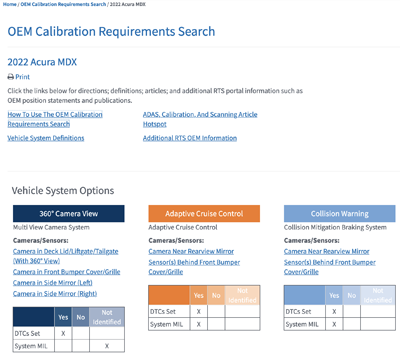Collision repair shops are obviously seeing more and more vehicles coming in for repairs that include advanced driver assistance systems (ADAS), and that means more and more vehicles are requiring calibrations of those systems as part of the repair.
There are a lot of great resources out there for determining which vehicles have systems that will need to be calibrated. I-CAR, for example, offers a free online search tool to find OEM calibration requirements.
Pull up the requirements for 2022 Acura MDX, for example, and the site shows what’s required related to the adaptive cruise control, collision warning, blind spot detection and about 10 other vehicle systems---there’s also a link at the top of the search results to a detailed page explaining how to use the requirements search.
But what I want to focus on here are some of the things often required by the automaker to be done---by your shop or by whatever sublet vendor you are using---to the vehicle prior to the calibration. There’s also “stall prep” work that must be done, but I’m focusing here on steps related to the vehicle itself.
This vehicle prep required for accurate calibration may include such items as verifying the fuel level in the vehicle, and adding fuel if necessary to meet the necessary conditions. It can include verifying the tire pressure, and the levels of other vehicle fluids in the vehicle like coolant or oil or washer fluid. It can include verifying the trunk doesn’t have any excess contents adding weight or “ballast.” You may have to check the back of the front seats to make sure there’s nothing in the seat pocket. An alignment is often a required step prior to calibrations.
When I’m working with estimators or repair planners, I always teach them to itemize these operations aside from the calibration line entry itself. Why?
Because there are variables. You may have two similar vehicles each requiring the same calibration, but one has the full fuel tank needed, while the other has only a half tank of gas, requiring an added step.
Speaking of which, let me tell you about an experience one collision repairer recently told me about when I was visiting the shop. The shop had added fuel to a vehicle because the calibration required a full tank of gas, but the vehicle had come into the shop with only a half-full tank.
After the customer picked up the repaired vehicle, he asked if the shop had added gas. The shop explained it was required as part of the calibration. The customer then asked what type was added. It turned out it wasn’t the type the customer used. He made such a stink about it, the shop had to drain the fuel and replace the fuel filters just to make the customer happy.
I think it’s going to become more important that shops ask vehicle owners to bring their vehicle in full of fuel whenever possible, explaining it’s necessary for proper calibrations. This is something that always should have been done in order to do a proper suspension alignment, but now it’s just as critical---or perhaps more so---for calibrations. And if you do need to add fuel, contact the customer ahead of time to avoid the type of situation this shop found itself in.
So the bottom line is estimates and invoices that include a calibration should also include lines items for whatever vehicle prep was required. Make sure you’re researching those requirements in the OEM information, and then make sure it’s being done properly. Don’t try to cheat it.
There are some OEMs that may say if you have a half-tank of gas, you can offset it by adding a set amount of weight added to the vehicle. But if the OEM doesn’t call that out, you need to make sure it has a full tank of gas.
The other thing: If you sublet your calibrations, you want to make sure these vehicle prep steps are done, either by your shop, if practical, before it goes to the sublet vendor, or by that sublet vendor. You may want to ask that sublet vendor to provide photos or other documentation that the necessary vehicle prep was done.














Mike Anderson